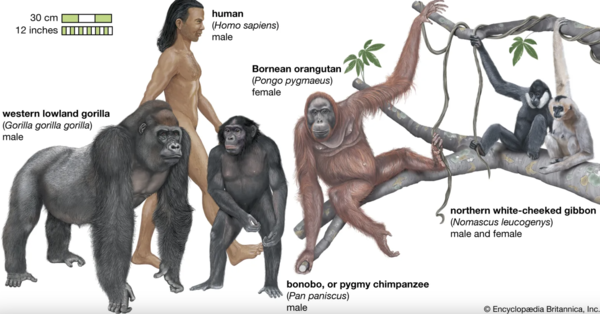Hominoidea, a fascinating group of primates encompassing great apes, lesser apes, and humans, represents a pinnacle of evolutionary adaptation and complexity. This article dives into the taxonomy, evolutionary history, unique physical traits, behavioral characteristics, and ecological significance of Hominoidea, highlighting the many facets of these remarkable creatures.

Hominoidea is a primate superfamily that includes humans (Homo sapiens), great apes (gorillas, chimpanzees, orangutans), and lesser apes (gibbons). These species share distinct traits such as large brains, lack of tails, and complex social structures, setting them apart from other primates.
Key Members:
Hominidae (Great Apes): Gorillas, chimpanzees, bonobos, orangutans, and humans.
Hylobatidae (Lesser Apes): Gibbons, known for their agility and vocal communication.
Order: Primates
Suborder: Haplorhini (dry-nosed primates)
Superfamily: Hominoidea
Hominoidea emerged about 25-30 million years ago, diverging from Old World monkeys. The evolutionary split between great apes and humans occurred approximately 6-8 million years ago, giving rise to the genus Homo and its extinct relatives like Australopithecus and Homo erectus.
Bipedalism: Seen in humans and their closest ancestors, this adaptation revolutionized mobility and freed the hands for tool use.
Large Brain-to-Body Ratio: Enhanced cognitive abilities, social behaviors, and cultural development.
No Tail: A defining feature of Hominoidea.
Flexible Shoulders and Limbs: Adapted for brachiation (swinging from trees) in lesser apes and climbing in great apes.
Robust Skull and Teeth: Suited for a diverse diet ranging from fruits to meat.
Social Structures:
Gorillas form harems led by dominant silverback males.
Chimpanzees and bonobos live in fission-fusion societies, emphasizing cooperation or conflict.
Tool Use and Problem Solving:
Chimps use sticks to fish termites; orangutans craft tools to retrieve food.
Communication:
Gibbons are known for their loud, melodic calls, while great apes use gestures and facial expressions.
Humans (Homo sapiens) are unique members of Hominoidea. Key differences include advanced tool use, language development, and cultural complexity. Fossil records, like Lucy (Australopithecus afarensis), highlight the gradual transition from arboreal life to upright walking.
Apes play vital ecological roles in their habitats, primarily tropical forests:
Seed Dispersal: Gorillas and orangutans spread seeds, maintaining forest biodiversity.
Predator-Prey Dynamics: As both predators (for small animals) and prey, they influence food webs.
Hominoidea species face habitat destruction, hunting, and climate change. Organizations like the Jane Goodall Institute and World Wildlife Fund focus on preserving their populations and ecosystems.
Tail: Monkeys have tails; apes do not.
Locomotion: Monkeys are quadrupedal, while apes exhibit brachiation or bipedalism.
Brain Size: Apes have larger brains, enabling complex behaviors.
Humans share about 98-99% of their DNA with chimpanzees, highlighting a close evolutionary bond. Cultural studies show how apes and humans share emotional expressions, social bonding, and problem-solving strategies.
Hominoidea is a remarkable group that bridges the gap between humans and the animal kingdom. From their evolutionary history to their critical ecological roles, understanding Hominoidea enriches our knowledge of life’s complexity. With ongoing conservation efforts, we can ensure that these incredible creatures continue to thrive.
animal tags: Hominoidea
We created this article in conjunction with AI technology, then made sure it was fact-checked and edited by a Animals Top editor.